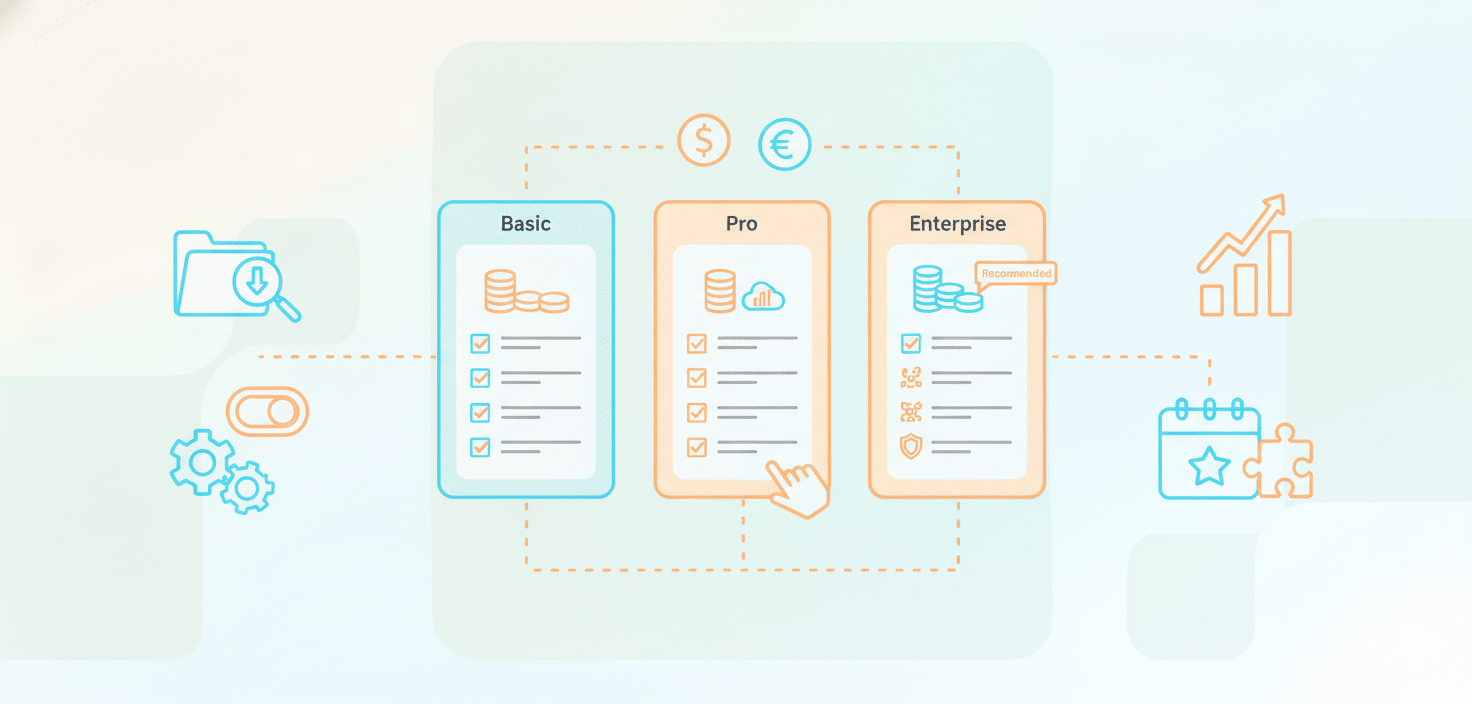Strategii de stabilire a prețurilor
Ce este stabilirea prețurilor pe bază de funcționalități?

Ce este stabilirea prețurilor pe bază de funcționalități pentru SaaS?
Tarifarea SaaS bazată pe funcționalități este un model de tarifare în care clienții plătesc în funcție de funcționalitățile specifice pe care le accesează și le utilizează.
Oferă flexibilitate și personalizare sporite în comparație cu modelele universale, permițând utilizatorilor să își personalizeze abonamentele conform nevoilor lor exacte.
Este necesară o planificare atentă, în special atunci când este combinat cu alte modele, pentru a evita confuzia clienților.
Care sunt avantajele și dezavantajele stabilirii prețurilor în funcție de funcționalități?
Acest model oferă avantaje distincte prin corelarea costului cu valoarea, dar vine și cu provocări notabile.
Beneficii (Avantaje)
- Transparență sporită: Clienții știu exact pentru ce plătesc, ceea ce clădește încrederea.
- Valoare percepută sporită: Utilizatorii simt că primesc mai mult pentru banii lor, selectând doar funcționalitățile de care au nevoie.
- Flexibilitate sporită: Clienții își pot crea un plan de abonament care se potrivește perfect cerințelor lor.
- Îmbunătățirea achiziției de clienți: Capacitatea de a oferi opțiuni variate atrage o bază mai largă de clienți, cu nevoi și bugete diferite.
Dezavantaje (Contra)
- Complexitate: Implementarea și gestionarea acestui model pot fi dificile, necesitând o monitorizare detaliată a utilizării funcționalităților.
- Potențial de sub-evaluare: Fără o calibrare atentă, unele funcționalități pot avea un preț subevaluat, afectând veniturile totale.
- Confuzia clienților: Prea multe opțiuni îi pot copleși pe clienți, ducând la “paralizia decizională”.
- Riscul de canibalizare a funcționalităților: După cum subliniază Baremetrics, o funcționalitate ar putea diminua în mod neintenționat valoarea alteia, dacă nu este tarifată corect.
Tarifare bazată pe funcționalități vs. tarifare pe niveluri: Care sunt principalele diferențe?
Înțelegerea distincției între tarifarea bazată pe funcționalități și cea pe niveluri este crucială pentru a alege strategia potrivită pentru afacerea dvs.
|
Aspect |
Tarifare bazată pe funcționalități |
Prețuri eșalonate |
|
Concept Central |
Clienții selectează și plătesc pentru funcționalități individuale sau pachete de funcționalități. |
Clienții aleg din pachete predefinite (niveluri) care includ o colecție prestabilită de funcționalități și limite de utilizare. |
|
Personalizare |
Ridicată. Clienții își creează propriile planuri. |
Scăzută spre medie. Clienții sunt limitați la opțiunile din cadrul fiecărui nivel. |
|
Alinierea la valoare |
Precisă. Costul este direct legat de valoarea funcționalităților specifice (Insight2Profit). |
Generală. Costul este legat de un grup de funcționalități, de unele dintre care un client s-ar putea să nu aibă nevoie. |
|
Administrare |
Complexă. Necesită investiții semnificative în urmărirea și gestionarea utilizării individuale a funcționalităților (Thales Group). |
Mai simplu. Mai ușor de comunicat și de gestionat câteva niveluri distincte. |
|
Ideal pentru… |
Produse cu o bază de utilizatori diversă și o gamă largă de funcționalități distincte și valoroase. |
Produse în care nevoile clienților pot fi grupate cu ușurință în segmente distincte (de ex., “Basic”, “Pro”, “Enterprise”). |
Ce factori influențează alegerea între tarifarea bazată pe funcționalități și cea pe niveluri?
Companiile SaaS trebuie să ia în considerare următoarele aspecte:
- Diversitatea nevoilor clienților: Dacă clienții dvs. au nevoi foarte variate, prețul bazat pe funcționalități este ideal. Dacă nevoile lor se grupează în câteva categorii, prețul pe niveluri este mai eficient.
- Complexitatea produsului: Platformele software complexe beneficiază adesea de prețul bazat pe funcționalități. Serviciile cu limite clare de utilizare (de ex., numărul de proiecte, spațiul de stocare) funcționează bine cu prețuri pe niveluri.
- Obiective strategice: Modelul dvs. de preț trebuie să se alinieze cu obiectivele dvs. financiare și strategice, ținând cont de concurența de pe piață și de datele despre clienți.
Este tarifarea bazată pe funcționalități potrivită pentru SaaS-ul meu?
Iată câteva elemente de care trebuie să țineți cont pentru a stabili dacă prețul SaaS bazat pe funcționalități este potrivit:
- Candidatul ideal: Acest model se potrivește foarte bine pentru produsele SaaS care sunt complexe și oferă o gamă largă de funcționalități.
- Cerință esențială: Trebuie să aveți capacitatea de a urmări date granulare de utilizare pentru a asigura facturarea corectă și optimizarea veniturilor.
- Recomandare: Este crucial să testați diferite strategii de prețuri, să monitorizați adoptarea funcționalităților și să aveți la dispoziție instrumente robuste pentru a gestiona eficient planurile.
Cum să implementați eficient tarifarea bazată pe funcționalități?
Iată pașii de urmat:
- Identifică caracteristicile de bază: Determinați ce funcționalități oferă cea mai mare valoare și pot fi diferențiate clar la diferite niveluri de preț.
- Concepeți planuri pe niveluri (Tiered): Grupați funcționalitățile în planuri logice (ex., Basic, Premium). Potrivit ScaleCrush, acest lucru ajută la satisfacerea unei game diverse segmente de clienți.
- Operaționalizați Facturarea & Urmărirea: Așa cum a subliniat Sage, trebuie să implementați un sistem robust pentru a gestiona facturarea complexă și a urmări cu precizie utilizarea. Acest lucru oferă informații valoroase privind adoptarea funcționalităților.
- Utilizați Tactici Strategice: Oferiți un versiune de încercare gratuită cu funcționalități limitate pentru a atrage utilizatorii. Utilizați ancorarea prețului prezentând valoarea planurilor premium în comparație cu cele de bază pentru a încuraja upgrade-urile.
- Iterați: Monitorizați continuu utilizarea funcționalităților și feedback-ul clienților pentru a vă rafina Strategia de prețuri.
Concluzie
O tactică eficientă pentru a alinia prețul unui produs la valoarea pe care o oferă este prețuirea bazată pe funcționalități. Oferind utilizatorilor autoritate asupra abonamentului lor, aceasta îi împuternicește, ceea ce poate îmbunătăți retenția și crește satisfacția clienților.
Cu toate acestea, această flexibilitate centrată pe client aduce dificultăți operaționale. Companiile trebuie să echilibreze avantajele alinierii exacte a valorii cu dificultățile de administrare și implementare.